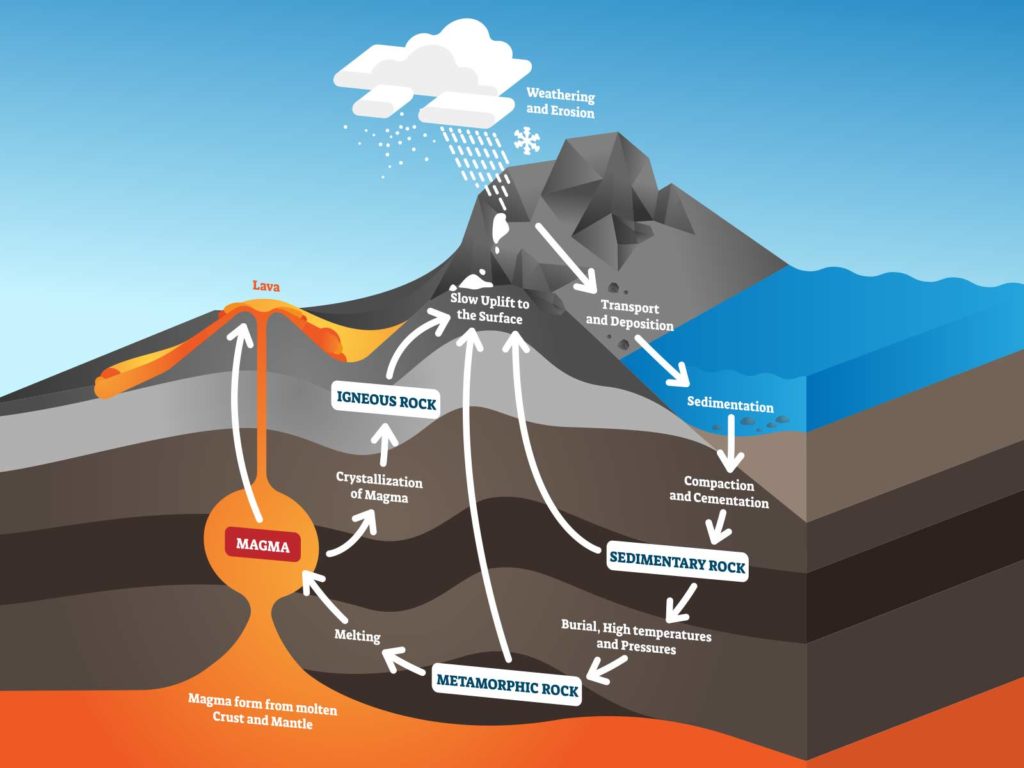Metamorphic rocks start out as one type of rock (but with heat, pressure, and time) gradually change into a new type of rock! Let’s look at how this happens and what kinds of rocks are metamorphic.
You probably already know the word metamorphosis from studying butterflies, how they change from a caterpillar into a butterfly after spending time in a cocoon. Similarly, rocks can undergo metamorphosis because they change from one thing into another!
In the rock cycle, there are three main types of rocks: Sedimentary, Igneous, and Metamorphic
- Sedimentary rocks were originally sediments, which were compacted under high pressure.
- Igneous rocks form when liquid magma or lava cools and hardens.
- Metamorphic rocks begin as either sedimentary or igneous rocks (or even another metamorphic rock) but change when exposed to the right conditions: high heat, high pressure, or to a hot mineral-rich fluid. Usually all three happen together!
For all three of these conditions to occur, we must go deep into the Earth’s crust or to a plate boundary where tectonic plates are colliding. The conditions must be just right though, as the rock needs to remain solid and not melt. If there is too much pressure or too much heat, the rock will melt and become magma. So metamorphic rocks are pretty special because they are often squished, spread out, and folded, but they do not get hot enough to melt. Amazing!

Metamorphic rocks form deep in the planet’s crust, but they are pushed up to the surface of the Earth through geologic uplift such as earthquakes or volcanoes, and through erosion of the rocks and soil above them. Let’s take a look at some of the rocks that change!

Granite -> Gneiss
Granite is an igneous rock that forms when magma cools slowly underground. When granite is exposed to the right amount of heat and pressure, it changes into gneiss. Igneous gemstones include peridot and diamond.

Limestone -> Marble
Limestone is a sedimentary rock that includes tiny broken-down pieces of fossils, shells, or coral. Under the right conditions it can change into marble. Sedimentary gemstones include opals, malachite and azurite.

Sandstone -> Quartzite
Quartz-rich sandstone is another kind of sedimentary rock primary made up of grains of sand. It can metamorphosize to form quartzite. You may have heard of quartz. Quartz is man-made, while quartzite is the natural stone.
Most gemstones form as minerals in the lower surface of the Earth’s crust, and the majority of them are formed by metamorphosis. Fluids escaping the magma below flow into fractures and cavities in the lower part of the crust. These conditions are perfect for the formation of crystals: high temperature, high pressure and room to grow. This is where diamonds form before volcanic explosions bring them closer to the surface. Interestingly, if they traveled upward more slowly with magma, they would melt, so the rapid nature of a volcanic eruption is the only way to bring these crystals towards the surface of the Earth.
Continue your rock & mineral exploration with our Rock Kits!
